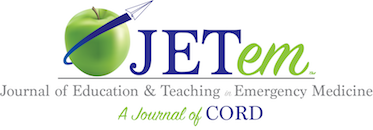Oral Boards
A Recipe for Disaster – Sodium Bicarbonate Overdose
DOI: https://doi.org/10.21980/J8MW85At the end of this oral board session, learners will be able to: 1) obtain a history which includes medications and other supplements used by the patient, 2) interpret a prolonged QTc, 3) diagnose metabolic alkalosis due to sodium bicarbonate toxicity, and 4) manage sodium bicarbonate toxicity with fluid and electrolyte resuscitation.
Posterior Reversible Encephalopathy Syndrome and Eclampsia
DOI: https://doi.org/10.21980/J8H64TAt the end of this oral boards session, examinees will be able to: 1) demonstrate familiarity with the structured interview oral board format and case play; 2) recognize the history and exam features concerning for PRES and eclampsia; 3) order appropriate diagnostic workup for postpartum and hypertensive emergencies including eclampsia and PRES; 4) understand treatment options for the management of eclampsia (intravenous [IV] magnesium sulfate, IV antihypertensive therapy, and emergent consultation with an obstetrician [OB/GYN]); 5) understand threshold for taking control of airway in patients with eclampsia; 6) understand indications for ordering brain imaging in patients with eclampsia and altered mental status; and 7) demonstrate effective communication with treatment team/family members as well as correct disposition of the patient to a higher level of care (intensive care unit [ICU]).
Diabetic Ketoacidosis and Necrotizing Soft Tissue Infection
DOI: https://doi.org/10.21980/J89M0KAt the end of this oral board session, examinees will: 1) Demonstrate the ability to obtain a complete medical history and physical exam. 2) Identify and appropriately treat DKA. 3) Identify, treat, and make appropriate consults for NSTI. 4) Demonstrate effective communication of the treatment plan with the patient.
Alcohol Withdrawal
DOI: https://doi.org/10.21980/J87S8QAt the end of this oral boards session, learners will: 1) demonstrate the ability to perform a detailed history and physical examination in a patient presenting with signs and symptoms of alcohol withdrawal, 2) investigate the broad differential diagnoses, including electrolyte abnormalities, trauma in the intoxicated patient, mild alcohol withdrawal, and delirium tremens, 3) list appropriate laboratory and imaging studies to include complete blood count (CBC), complete metabolic panel (CMP), magnesium level, computed tomography (CT) scan of the brain; 4) understand the management of hypoglycemia with concurrent administration of thiamine to prevent Wernicke’s encephalopathy and subsequent Korsakoff syndrome, 5) appropriately treat acute alcohol withdrawal with intravenous (IV) hydration and benzodiazepines, phenobarbital, or alternative medications, and 6) understanding the need for the complex management of these patients, appropriately disposition the patient to the intensive care unit after consulting with critical care specialists.
Calcium Channel Blocker Overdose
DOI: https://doi.org/10.21980/J8CQ07At the end of this oral board session, examinees will: (1) demonstrate ability to evaluate a patient with undifferentiated shock with bradycardia and discuss the differential diagnosis, (2) recognize the signs and symptoms of calcium channel blocker overdose, (3) demonstrate ability to manage treatment of a patient with calcium channel overdose.
Acute Pulmonary Edema and NSTEMI
DOI: https://doi.org/10.21980/J8CW67At the end of this practice oral boards case, the learner will: 1) recognize unstable vital signs (VS) and intervene to stabilize ventilation and oxygenation, 2) demonstrate the ability to obtain a complete medical history including the important characteristics of chest pain, 3) demonstrate an appropriate exam on a patient, 4) order the appropriate evaluation studies for a patient with complaints of dyspnea, 5) interpret the results of diagnostic evaluation and diagnose Non- ST elevation myocardial infarction (NSTEMI) and pulmonary edema, 6) order appropriate management of pulmonary edema and NSTEMI, and 6) demonstrate effective communication with patient and family members.
Infant Botulism
DOI: https://doi.org/10.21980/J88350At the end of this oral board session, examinees will: 1) demonstrate an ability to obtain a complete pediatric medical history, 2) perform an appropriate physical exam on a pediatric patient, 3) investigate a broad differential diagnosis for neuromuscular weakness in a pediatric patient, 4) recognize the classic presentation of infant botulism and implement treatment with botulinum specific antitoxin before confirmatory testing, 5) recognize impending airway failure and intubate the pediatric patient with appropriately dosed medications and ET tube size, and 6) demonstrate effective communication with healthcare team members and parents.
Acute Chest Syndrome
DOI: https://doi.org/10.21980/J80S8JAt the end of this oral board session, examinees will: 1) demonstrate the ability to obtain a complete medical history; 2) demonstrate the ability to perform a detailed physical examination in a patient with respiratory distress; 3) identify a patient with respiratory distress and hypoxia and manage appropriately (administer oxygen, place patient on monitor); 4) investigate the broad differential diagnoses which include acute chest syndrome, pneumonia, acute coronary syndrome, acute congestive heart failure, acute aortic dissection and acute pulmonary embolism; 5) list the appropriate laboratory and imaging studies to differentiate acute chest syndrome from other diagnoses (complete blood count, comprehensive metabolic panel, brain natriuretic peptide (BNP), lactic acid, procalcitonin, EKG, troponin level, d-dimer, chest radiograph); 6) identify a patient with acute chest syndrome and manage appropriately (administer intravenous pain medications, administer antibiotics after obtaining blood cultures, emergent consultation with hematology) and 7) provide appropriate disposition to the intensive care unit after consultation with hematology.
